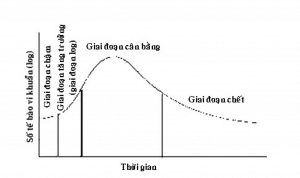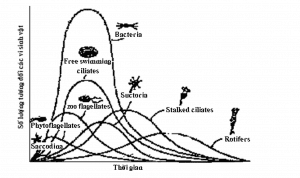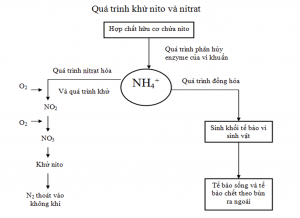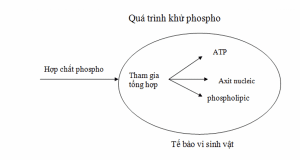Wastewater treatment using biological methods
Biological methods are applied to treat dissolved organic substances in wastewater as well as some inorganic substances such as H2S, Sulfite, Ammonia, Nitrogen,… based on Microbial activity to decompose organic pollutants. Microorganisms use organic matter and some minerals as food to grow and develop. In general, biological treatment methods can be divided into two types:
- The anaerobic method uses a group of anaerobic microorganisms, operating in the absence of oxygen;
- The aerobic method uses a group of aerobic microorganisms, operating under conditions of continuous oxygen supply.
The process of decomposing organic substances by microorganisms is called biochemical oxidation. To carry out this process, dissolved organic substances, both colloidal and small dispersed substances in wastewater need to move inside microbial cells in three main stages as follows:
- Transfer of contaminants from the liquid phase to the microbial cell surface;
- Diffusion from the cell surface through a semi-permeable membrane due to the difference in concentration inside and outside the cell;
- Metabolize substances in microbial cells, produce energy and synthesize new cells.
The rate of biochemical oxidation depends on the concentration of organic matter, the content of impurities and the stability of the wastewater flow into the treatment system. At each given treatment condition, the main factors affecting the biochemical reaction rate are hydrodynamic regime, oxygen content in wastewater, temperature, pH, nutrients and trace elements.
Concept of aerobic biological processes
Aerobic biological process is the oxidation of carbon-containing organic substances that are easily biodegradable (usually expressed by indicators: BOD, COD, TOC – total organic carbon) with the participation of microorganisms. Aerobic organisms in the presence of oxygen.
Principles of aerobic biological processes
The principle of this process is to use aerobic microorganisms to decompose organic substances in wastewater with adequate dissolved oxygen at appropriate temperature, pH, etc.
The process of decomposing organic matter by aerobic microorganisms can be described by diagram:
(FOR)nNS + O2 -> CO2 + H2O + NH4 + H2S + Microbial cells + … ΔH
Under aerobic conditions NH4+ and H2S are decomposed through nitrification and sulfation by autotrophic microorganisms. :
NH4+ + 2O2 -> NO3– + 2H+ + H2O + ΔH;
H2S + 2O2 -> SO4+ + 2H+ + ΔH
Aerobic microbial activity includes:
- Nutrition process: microorganisms use organic substances, nutrients and metal trace elements to build new cells to increase biomass and reproduction.
Decomposition process: microorganisms oxidize dissolved organic substances or in the form of small dispersed colloidal particles into water and CO2 or create other gases
Advantages and disadvantages of aerobic biological wastewater treatment method
Advantages:
- Compared with the anaerobic method, aerobic technology has the advantages of a more complete understanding of the treatment process, higher treatment efficiency and more thoroughness.
- Aerobic methods do not cause secondary pollution like chemical and physical chemical methods.
Disadvantages:
- But the aerobic method also has disadvantages: the building volume is large and takes up more space.
- Larger construction costs and equipment investment.
- Operating costs, especially costs for aeration energy, are relatively high.
- No ability to recover energy. Not tolerant of sudden changes in organic load.
- After treatment, a residual amount of sludge is generated and this amount of sludge is less stable, thus requiring investment costs to treat sludge.
- Treating wastewater with loading loads not as high as anaerobic methods.
Describe aerobic biological processes
The process of decomposing organic dirt using aerobic biotechnology is a fermentation process with microorganisms in the presence of oxygen to produce products CO2, H2< /sub>O, NO3‑ and SO42-. During aerobic treatment, complex impurities such as proteins, starches, fats… will be decomposed by extracellular enzymes into simple substances such as amino acids, fatty acids, organic acids, applicant… These simple substances will permeate the cell membrane and be further decomposed or converted into new cell building materials by the process of intracellular respiration giving the final product CO2 and H2O. The aerobic process mechanism includes 3 stages:
Phase 1: Oxidize all organic matter in wastewater to meet the energy needs of cells:
CxHyOzN + (x+ y/4 + z/3 + ¾) O2 yeast —- > xCO2 + [ (y-3)/2] H2O + NH3
In biological treatment tanks, bacteria play a key role because they are responsible for decomposing organic components in wastewater. In activated sludge tanks, part of the organic matter will be used by aerobic and facultative aerobic bacteria to obtain energy to synthesize the remaining organic matter into new bacterial cells. When the treatment tanks are completed and put into operation, the bacteria present in the wastewater begin to grow according to the growth cycle of bacteria in a batch of microorganisms. In the beginning, to soon put the treatment system into operation, add a new tank as a form of adding bacteria to the treatment tank. The growth cycle of bacteria in the treatment tank includes 4 stages:
- Lag-phase: occurs when the tank begins to operate and sludge from other tanks is added to the tank. This is the stage for bacteria to adapt to the new environment and begin the cell division process.
- Growth phase (log-growth phase): during this phase, bacterial cells divide and increase rapidly in number. The rate of cell division depends on the time required for cell divisions and the amount of food in the environment.
- Equilibrium phase: at this time the bacterial density is kept at a stable number. The reason for this stage is that the nutrients necessary for the growth of microorganisms have been used up, the number of bacteria born is equal to the number of bacteria that have died.
- Log-death phase: during this phase, the number of bacteria that die is greater than the number of bacteria that are born, so the density of bacteria in the tank decreases rapidly. This stage may be caused by species of generally visible size or by characteristics of the environment.

Graph of bacterial growth in a biological treatment tank

Graph of relative growth of microorganisms in wastewater treatment tanks
In wastewater treatment tanks bacteria play a leading role. Therefore in these tanks we must maintain a high bacterial density compatible with the amount of pollutants introduced into the tank. This can be done through the design and operation process. During the design process, we must accurately calculate the residence time of bacteria in the treatment tank and this time must be large enough for the bacteria to Bacteria can reproduce. During operation, the necessary conditions for bacterial growth (pH, nutrients, temperature, mixing…) must be adjusted to the most favorable level for bacteria.
Phase 2: substrate metabolism:
+ Oxidation and cellular synthesis (anabolic processes):
CxHyOzN + NH3+ O2 yeast – — > xCO2 + C5H7NO2
+ Intracellular respiration process (catabolic process):
C5H7NO2 + 5O2 yeast — > xCO2+H2O
NH3+ O2 yeast — > O2+ HNO2 yeast — > HNO3
When there is not enough substrate, the metabolism of cellular substances begins to occur by autoxidation of cellular material.
Stage 3: Nitrogen and Phosphorus Reduction Process:


Suspended aerobic microbial process
Concept: The process of suspended aerobic microorganisms is the process in which microorganisms reproduce and develop into activated sludge flocs in a suspended state. Treatment works include: aeroten tanks, oxidation ditches, SBR tanks…
Aerobic biological treatment with suspended microorganisms is mainly used to remove carbon-containing organic matter such as activated sludge processes, aeration ponds, intermittent reactors, and fermentation processes. aerobic decomposition. Among these processes, the activated sludge process is the most common.
Activated Sludge Process
Activated sludge consists of living organisms aggregated into granules or flocs with a center of suspended solid substrates (40%). The substrate in activated sludge can be up to 90% solids of moss, algae and various solid residues. Aerobic sludge is in the form of yellow-brown, easily settled flocs and is an amorphous colloidal system, while anaerobic sludge is in the form of flocs or black granules. Organisms that live in mud are unicellular or multicellular bacteria, yeasts, molds, actinomycetes, protozoa and lower animals, maggots, worms, and sometimes insect larvae. The basic role in the activated sludge wastewater cleaning process is bacteria, which can be divided into 8 groups:
- Alkaligenes- Achromobacter
- Pseudomonas
- Enterobacteriaceae
- Athrobacter baccillus
- Cytophaga- Flavobacteriaum
- Pseudomonas- Vibrio aeromonas
- Achrobacter
- Mixture of other bacteria; Ecoli, Micococus
In wastewater, there are Zooglea cells that have the ability to produce mucus cells around the cells, which bind bacteria, suspended particles, colorants, odorants, etc. and develop into flocs. These flocs, when stirred and blown with air, will gradually grow by adsorbing many small suspended solid particles, microbial cells, protozoa and toxins. When these cotton particles stop blowing air or when substrates are exhausted, they will settle to create activated sludge. In activated sludge, protozoa are always present, represented by Sarcodina, Mastigophara, Ciliata, Suctoria and several other complex organisms. The relationship between protozoa and bacteria is a “prey – predator” relationship that belongs to the balance of organic matter – bacteria – protozoa. When sludge settles, it is “old sludge” and sludge activity is reduced. Sludge activity can be reactivated by providing adequate nutrients and organic substrates. The activated sludge formula commonly used in calculations is C5H7O2N.
Factors affecting suspended aerobic microbial processes
- The aerobic treatment process is influenced by the concentration of activated sludge, which depends on the sludge index. The lower the sludge index, the greater the sludge concentration put into the treatment works or vice versa.
- Oxygen concentration also strongly affects this process. When carrying out the process, a sufficient amount of oxygen must be continuously supplied so that the amount of dissolved oxygen in the water leaving the second phase sedimentation tank >= 2 (mg/l).
- Unlike the anaerobic process, the organic load in aerobic treatment is usually lower, so the concentration of organic impurities in wastewater through Aeroten with total BOD must be =< 1000 (mg/l), while in the biological filter tank, the total BOD of wastewater =<500 (mg/l).
- In addition, wastewater also needs trace elements such as K, Na, Mg, Fe, Ca, Mo, Ni, Co, Zn, Cu, S, Cl… which are usually enough in wastewater. Depending on the substrate content in wastewater, there are different requirements for the concentration of necessary nutritional elements. Normally it is necessary to maintain nutritional elements in an appropriate ratio: BODtotal : N: P = 100: 5: 1
- Activated sludge has the ability to absorb heavy metal salts. At that time, the biological activity of the sludge decreases, the sludge will swell and be difficult to settle due to the intense growth of filamentous bacteria. Therefore, the concentration of toxins and heavy metals in wastewater must be within allowable limits.
Environmental factors:
- pH: is a major factor in the growth of microorganisms. Most microorganisms cannot tolerate pH > 9 because this will destroy the balance of cell protoplasm, causing microorganisms to die and pH < 4 will promote mushroom growth. Normally, the optimal pH for microorganisms to grow best is in the range of 6.5 – 7.5.
- Temperature: is also an important factor for the growth of microorganisms. Wastewater has an optimal temperature suitable for most microorganisms from 25oC – 37oC or from 20 – 80 oC or from 20 – 40oC (optimum 25oC – 37oC).
- In addition, the aerobic treatment process also depends on the concentration of inorganic salts, the amount of suspended matter flowing into the treatment tank as well as the species of microorganisms and the structure of organic contaminants.


Related articles
UASB tank in wastewater treatment
Introducing the UASB tank UASB stands for Upflow Anaerobic Sludge Blanket, roughly translated as reverse...
Wastewater treatment of carton paper packaging production
Origin of wastewater from carton packaging production Wastewater containing printing ink generated during the production...
Common Aerotank tank problems and how to fix them
Aerotank incidents during the operation of the WWTP often arise equipment problems such as pumps,...